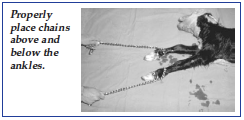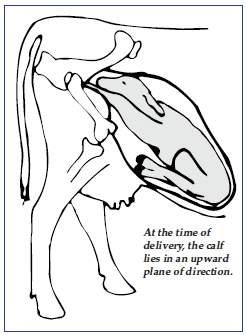Download the PDF | Email for Questions
Parturition | Assisting Parturition | Post Parturition
Dystocia is the scientific word used to describe a difficult delivery during the birthing process. In cattle, such difficulty occurs most frequently in first-calf heifers. On the average, 50 percent of dystocias in cattle occur in first-calf heifers and 25 percent occur in second-calf heifers. The remaining dystocias are distributed throughout the rest of the calving cow herd.
Calving difficulty is frequently casued by disproportionate size – the calf is too big for the birth canal. The weight of the calf at birth is the most important factor influencing calving ease; other factors are the calf’s breed, sex and conformation.
Parturition
The entry of a fetus into the birth canal during parturition (birthing process, labor) is described by three terms. These are presentation, position and posture. Presentation refers to whether the fetus is coming forwards, backwards or sideways. Position refers to whether the fetus is right side up or upside down. Posture refers to whether the head and neck are in proper position or if the feet and legs are in the proper relationship to the body for delivery. Improper presentation, position or posture can result in dystocia.
Normal parturition is a continuous process, but is often divided into three stages for purposes of description. Stage 1 is cervical dilation. Stage 2 is expulsion of the fetus. Stage 3 involves expulsion of the fetal membranes. The time sequences involved wiht these stages can be helpful in determining if dystocia is occuring. Stage 1 labor begins with initial contraction of the uterus and ends when the cervix is dilated and fetal parts (feet, nose) enter the birth canal. Visible signs of labor usually are absent during this stage. The heifer or cow will be restless and have a tendency to lie down and get up frequently. Stage 1 lasts from 2 to 6 hours, sometimes longer in heifers.
Stage 2 labor begins when fetal parts enter the birth canal and stimulate the abdominal press. The first water bag (chorioallantoic sac) usually ruptures early in Stage 2. The second water bag (amniotic sac) is often forced through the vulva after the cow has been in labor for a short time. Delivery should be completed within 2 hours after the appearance of the amniotic sac at the vulva. Stage 2 labor may last from 30 minutes to 4 hours.
Stage 3 labor, or expulsion of the fetal membranes, usually is completed within 8 to 12 hours following delivery of the fetus.
Assisting Parturition
Assistance should be provided if the cow or heifer has been in stage 1 labor for 6 hours or more and the abdominal press has not begun. If the female is in stage 2 labor with signs of abdominal pressing for 2 hours and no fetal parts have been presented, she should be examined. If a cow is observed with a water sac presented through the vulva and has not delivered the fetus within 2 hours, she should be assisted.
When fetal parts protrude through the vulva to the outside, the heifer or cow should be observed at hourly intervals. If no progress is made within an hour or the nose protrudes further than the feet, she should be assisted. Assistance is not necessary if progress occurs during the hourly observations. As normal progress develops, she should calve within 4 hours.
A high percentage of cows and heifers that calve unassisted contaminate their reproductive tract. Fortunately, they are able to overcome infection and become pregnant again.
To prevent gross and potentially overwhelming contamination during assisted calving, properly restrain the heifer or cow. Restrain by using a low head tie, not a chute, to give the animal room to lie down during assisted delivery. Thoroughly cleanse the perineum or rear portions of the animal before examining the birth canal. Liberally apply mild soap and water and rinse thoroughly the area of the tail head down to an area approximately 12 inches below the vulva. The width of the scrubbed area should extend laterally to include the pin bones. The tail can be tied to the animal’s neck or elbow to keep it out of the way during assistance. The assistant’s hands and arms should be cleansed with soap, water and an antiseptic solution.
Examination through the vagina reveals the diameter of the bony pelvic canal. Cervical dilation is limited to the size of the pelvic bones, therefore, a decision as to whether or not a cesarean is necessary should be made before initiating assistance.
The delivery of the fetus is eased by the use of obstetrical chains. Cotton ropes and nylon web obstetrical straps also can be used. Chains are preferred because they can be easily cleaned and sanitized by boiling in water between calvings. Chains allow for more accurate placement of handles, which increases traction. Chains also are less restrictive to circulation. When chains are laid aside during assistance, place them in a disinfectant solution to keep them clean.
 The best placement of a rope or chain on the limb of a calf is a loop above the ankle and a half-hitch below the ankle. This distributes the point of pull to reduce the potential of fracturing a fetal limb during delivery. Place the chains or other straps directly on the skin. Placing them over the second water sac covering the limbs while applying traction will impede delivery.
The best placement of a rope or chain on the limb of a calf is a loop above the ankle and a half-hitch below the ankle. This distributes the point of pull to reduce the potential of fracturing a fetal limb during delivery. Place the chains or other straps directly on the skin. Placing them over the second water sac covering the limbs while applying traction will impede delivery.
Adequate lubrication is essential in assisted delivery when a cow or heifer is in dystocia. Although nature has provided the calving cow with ample amounts of lubricant, the heifer or cow in dystocia often expends her natural lubricating fluids. Delivering a fetus through a relatively dry birth canal may well add unnecessary trauma to the dam.
Petroleum-based jellies or solid cooking compounds make satisfactory lubricants. A water slurry made with baby-clothes detergents (non-bleaching or non-harsh detergents) can be used as well. Apply lubricants liberally and frequently during assistance.
The calf is delivered by walking the calf out. This is accomplished by alternating the pull on each leg. Pull one leg, one at a time, with a maximum traction of 200 pounds to fully extend both legs before applying more traction to pull the calf. Pull in an upward direction.
 Be sure to keep the nose in position with the ankles and continue to pull upward to deliver the calf beyond its shoulders. Then pull downward, through an arc, to complete delivery of the calf. The maximum traction to apply to the calf with extended legs is 600 pounds. If assistance is attempted using the guidelines to walk the calf out and progress is not made after working 30 minutes, obtain professional help immediately.
Be sure to keep the nose in position with the ankles and continue to pull upward to deliver the calf beyond its shoulders. Then pull downward, through an arc, to complete delivery of the calf. The maximum traction to apply to the calf with extended legs is 600 pounds. If assistance is attempted using the guidelines to walk the calf out and progress is not made after working 30 minutes, obtain professional help immediately.
Fetal extractors, or calf-pullers, often are used to assist delivery of a calf. These instruments can prove to be invaluable, but they also can be dangerous. Excessive traction with this instrument can tear cows and even cause paralysis. Regardless of the type of calf-puller used, a quick-release mechanism is essential. Avoid using extractors without this feature. Apply no more traction with a fetal extractor than can be supplied by three strong men. If traction for delivery is applied to a standing animal, the pressure will often cause the animal to lie down. Make sure enough room is provided for the animal to lie down and for the attendants to work.
Post Parturition
After the calf has been delivered, check for a heart beat by placing a hand on the lower chest just behind the front limbs. Another way to determine if the calf is alive is to gently touch the surface of the eyeball. A blinking reflex indicates life.
After delivering a live fetus, the next critical step is to provide an open airway for breathing. Use a dry paper or cloth towel to wipe the mouth of excess mucus. Stimulate respiration by placing a piece of hay or straw in the nostril to initiate a sneeze and clear the airway. Insert a finger in the calf’s rectum to initiate a respiratory response, also. Vigorous rubbing of the back of the calf also can stimulate breathing.
After the calf is breathing and relatively stable, tend to the calf’s umbilicus. Treat it with a minimum 2 percent solution of iodine. This preventive practice greatly reduces the chance of the calf developing a systemic illness later.
 Also, make sure the calf drinks 1 to 2 quarts of colostrum (first-milk) from the dam within the first 6 hours of life. It is best when nursed, but if the calf is too weak, provide the colostrum by stomach tube. If the calf is small, divide the colostrum into two to three feedings during the first 6 hours.
Also, make sure the calf drinks 1 to 2 quarts of colostrum (first-milk) from the dam within the first 6 hours of life. It is best when nursed, but if the calf is too weak, provide the colostrum by stomach tube. If the calf is small, divide the colostrum into two to three feedings during the first 6 hours.
After delivery, re-examine the birth canal of the dam. The most important consideration is to check for the presence of an additional fetus. Also examine the posterior birth canal for excessive tearing or bruising that could require a veterinarian’s observation. Allow the cow to naturally expel the placenta because it is too tightly attached at this time for manual removal. Administer intrauterine boluses or parenteral injections of antibiotics after consultation with a veterinarian regarding approved usage and withdrawal time of antibiotics.